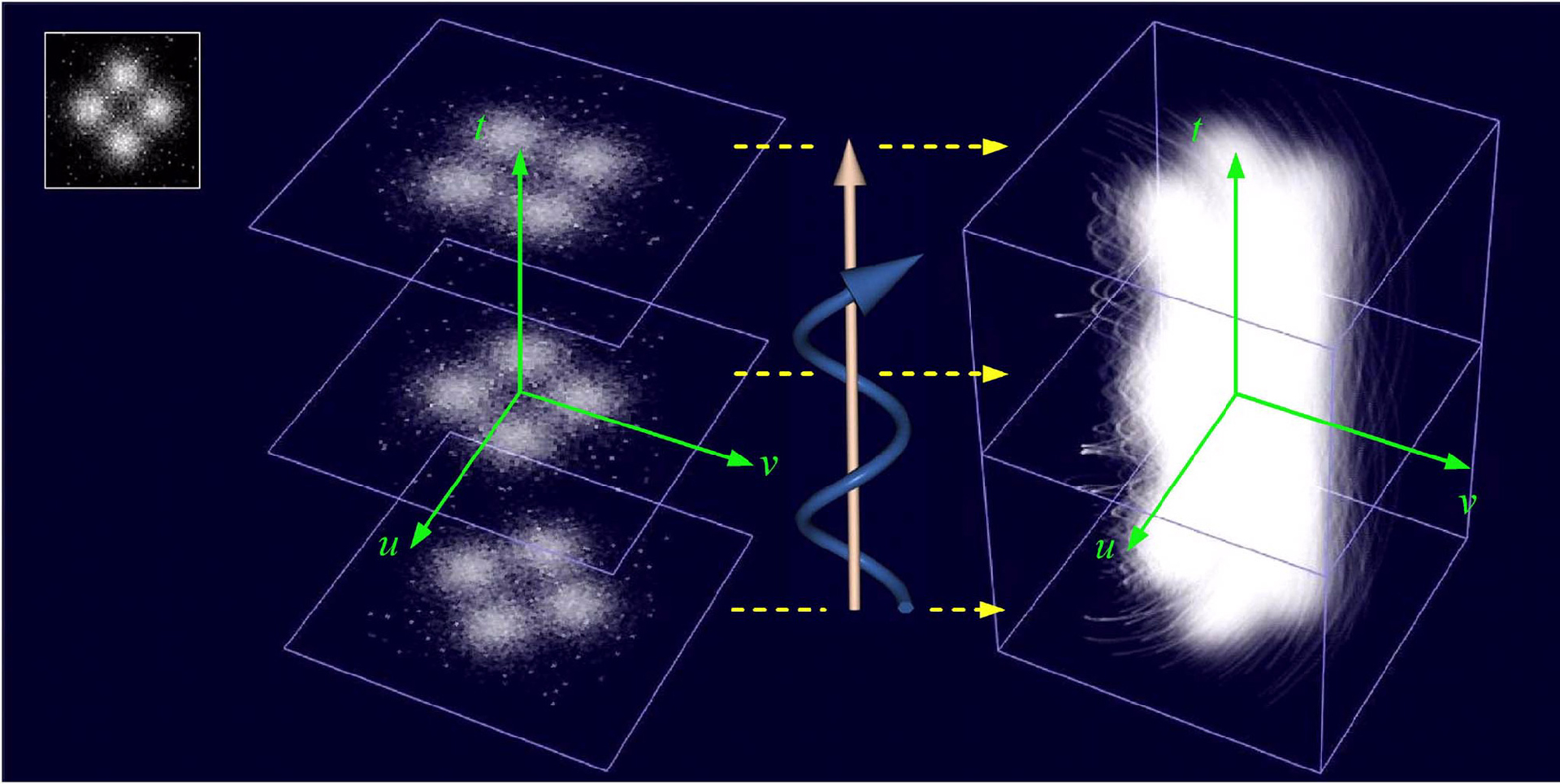“Photorealistic rendering of knitwear using the lumislice” by Xu, Chen, Lin, Zhong, Wu, et al. …
Conference:
Type(s):
Title:
- Photorealistic rendering of knitwear using the lumislice
Presenter(s)/Author(s):
Abstract:
We present a method for efficient synthesis of photorealistic free-form knitwear. Our approach is motivated by the observation that a single cross-section of yarn can serve as the basic primitive for modeling entire articles of knitwear. This primitive, called the lumislice, describes radiance from a yarn cross-section based on fine-level interactions — such as occlusion, shadowing, and multiple scattering — among yarn fibers. By representing yarn as a sequence of identical but rotated cross-sections, the lumislice can effectively propagate local microstructure over arbitrary stitch patterns and knitwear shapes. This framework accommodates varying levels of detail and capitalizes on hardware-assisted transparency blending. To further enhance realism, a technique for generating soft shadows from yarn is also introduced.
References:
1. K. Anjyo, Y. Usami, and T. Kurihara. A Simple Method for Extracting the Natural Beauty of Hair. Computer Graphics (Proceedings of SIGGRAPH 92), 26(2):111-120, July 1992.
2. D. Baraff and A. Witkin. Large Steps in Cloth Simulation. Proceedings of SIGGRAPH 98, pages 43-54, July 1998.
3. D. E. Breen, D. H. House, and P. H. Getto. A Physically-Based Particle Model of Woven Cloth. The Visual Computer, 8(5-6):264-277, June 1992.
4. D. E. Breen, D. H. House, and M. J. Wozny. Predicting the Drape of Woven Cloth Using Interacting Particles. Proceedings of SIGGRAPH 94, pages 365-372, July 1994.
5. D. E. Breen, D. H. House, and M. J. Wozny. A particle-based model for simulating the draping behavior of woven cloth. Textile research joural, 64(11):663- 685, November 1994.
6. S. Chandrasekar. Radiative Transfer. Dover Publications, New York, 1960.
7. M. Courshesnes, P. Volino, and N. M. Thalmann. Versatile and Efficient Techniques for Simulating Cloth and Other Deformable Objects. Proceedings of SIG- GRAPH 95, pages 137-144, August 1995.
8. K. J. Dana, B. van Ginneken, S. K. Nayar, and J. J. Koenderink. Reflectance and Texture of Real-world Surfaces. ACM Transactions on Graphics, 18(1):1-34, January 1999.
9. B. Eberhardt, A. Weber, and W. Straber. A Fast, Flexible, Particle-System Model for Cloth Draping. IEEE Computer Graphics & Applications, 16(5):52-60, September 1996.
10. D. B. Goldman. Fake Fur Rendering. Proceedings of SIGGRAPH 97, pages 127-134, August 1997.
11. S. J. Gortler, R. Grzeszczuk, R. Szeliski, and M. F. Cohen. The Lumigraph. Proceedings of SIGGRAPH 96, pages 43-54, August 1996.
12. E. Groller, R. T. Rau, and W. Straber. Modeling and Visualization of Knitwear. IEEE Transactions on Visualization and Computer Graphics, 1(4):302-310, December 1995.
13. E. Groller, R. T. Rau, and W. Straber. Modeling Textiles as Three Dimensional Textures. Eurographics Rendering Workshop 1996, pages 205-214, June 1996.
14. Harmony. The Harmony Guide to Knitting Techniques. Collins & Brown, 1992.
15. D. H. House and D. E. Breen. Cloth Modeling and Animation. A K Peters, Natick Massachusetts, 2000.
16. J. T. Kajiya and T. L. Kay. Rendering Fur with Three Dimensional Textures. Computer Graphics (Proceedings of SIGGRAPH 89), 23(3):271-280, July 1989.
17. J. Lengyel. Real-Time Fur. Eurographics Rendering Workshop 2000, pages 243-256, June 2000.
18. M. Levoy and P. Hanrahan. Light Field Rendering. Proceedings of SIGGRAPH 96, pages 31-42, August 1996.
19. T. Lokovic and E. Veach. Deep Shadow Map. Proceedings of SIGGRAPH 2000, pages 385-392, July 2000.
20. A. Meyer and F. Neyret. Interactive Volumetric Textures. Eurographics Rendering Workshop 1998, pages 157-168, June 1998.
21. F. Neyret. Modeling, Animating, and Rendering Complex Scenes Using Volumetric Textures. IEEE Transactions on Visualization and Computer Graphics, 4(1):55-70, January-March 1998.
22. W. T. Reeves, D. H. Salesin, and R. L. Cook. Rendering Antialiased Shadows with Depth Maps. Computer Graphics (Proceedings of SIGGRAPH 87), 21(4):283-291, July 1987.
23. B. Robertson. Building a better mouse. Computer Graphics World, 22(12), December 1999.
24. C. Soler and F. X. Sillion. Fast Calculation of Soft Shadow Textures Using Convolution. Proceedings of SIGGRAPH 98, pages 321-332, July 1998.
25. D. Terzopoulos and K. Fleischer. Deformable models. The Visual Computer, 4(6):306-331, December 1988.
26. N. M. Thalmann, S. Carion, M. Courchesne, P. Volino, and Y. Wu. Virtual Clothes, Hair and Skin for Beautiful Top Models . Computer Graphics International, 1996.
27. L. R. Wanger, J. A. Ferwerda, and D. P. Greenberg. Perceiving Spatial Relationships in Computer-Generated Images. IEEE Computer Graphics and Application, 12(3):44-58, May 1992.
28. S. H. Watson, J. R. Arvo, and K. E. Torrance. Predicting Reflectance Functions From Complex Surfaces. Computer Graphics (Proceedings of SIGGRAPH 92), 26(2):255-264, July 1992.
29. J. Weil. The Synthesis of Cloth Objects. Computer Graphics (Proceedings of SIGGRAPH 86), 20(4):49-54, August 1986.
30. S. H. Westin, J. R. Arvo, and K. E. Torrance. Predicting Reflectance Functions From Complex Surfaces. Computer Graphics (Proceedings of SIGGRAPH 92), 26(2):255-264, July 1992.
31. L. Williams. Casting Curved Shadows on Curved Surfaces. Computer Graphics (Proceedings of SIGGRAPH 78), 21(3):270-274, August 1978.
32. T. Yasuda, S. Yokoi, and J. Toriwaki. A Shading Model for Cloth Objects. IEEE Computer Graphics & Applications, 12(6):15-24, November 1992.
33. H. Zhong, Y. Xu, B. Guo, and H. Shum. Realistic and Efficient Rendering of Free-Form Knitwear. Journal of Visualization and Computer Animation, Special Issue on Cloth Simulation, 2000.




